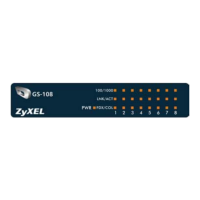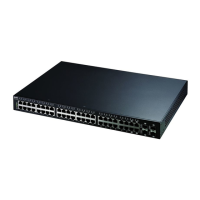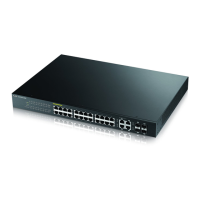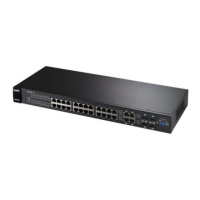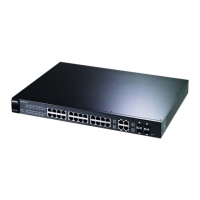
Do you have a question about the ZyXEL Communications GS-1524 and is the answer not in the manual?
| Ports | 24 |
|---|---|
| Uplink Ports | 2 |
| Switching Capacity | 48 Gbps |
| Forwarding Rate | 35.7 Mpps |
| MAC Address Table | 8K |
| Jumbo Frame Support | Yes |
| Power Supply | Internal |
Manual target users, requiring basic TCP/IP knowledge.
Provides contact information for problems not solved by the manual.
Lists warnings about product usage, environment, electrical safety, and handling.
Introduces main features and applications of the switch.
Guides on how to install and connect the switch.
Shows and describes the front panel of the GS-1524 and GS-1548.
Describes how to reset the switch to factory defaults using the RESET button.
Introduces the HTML-based management interface for switch setup and management.
Describes system screens for general information and maintenance.
Covers viewing and configuring port settings on the switch.
Details how to configure IEEE 802.1Q tagged VLANs.
Introduces Quality of Service parameters for prioritizing traffic.
Covers managing bandwidth per port and setting storm control.
Details the steps to start a web browser and log into the switch.
Details how to reset the switch to factory defaults using the RESET button.
Describes the home screen for general system info and maintenance.
Guides on downloading and upgrading the switch firmware.
Details configuring individual port settings like Admin, Speed/Duplex, Flow Control.
Explains VLANs using explicit tags (VLAN ID) in the MAC header.
Guides on creating new VLANs and configuring member ports.
Explains QoS for solving performance degradation during network congestion.
Guides on specifying queuing methods and configuring queue weights.
Shows ways to inspect logs and configure an external log server.
Describes using Simple Network Management Protocol to manage and monitor the switch.
Offers suggestions to solve potential problems encountered with the switch.
Explains configuring the switch to save specific events in different log targets (RAM, Flash, Server).
Guides on specifying system events to record and where to save logs.
Explains SNMP as an application layer protocol for managing and monitoring devices.
Explains SNMP communities as security parameters for SNMP clients.
Provides troubleshooting steps for power issues and LED behavior.
Offers solutions for forgetting IP address, username, or password.
Lists physical and environmental specifications like LEDs, dimensions, weight, and power.
Introduces IP addresses and subnet masks and their concepts.
Explains subnet masks determining network vs. host ID bits.
Describes dividing a network into multiple sub-networks.

